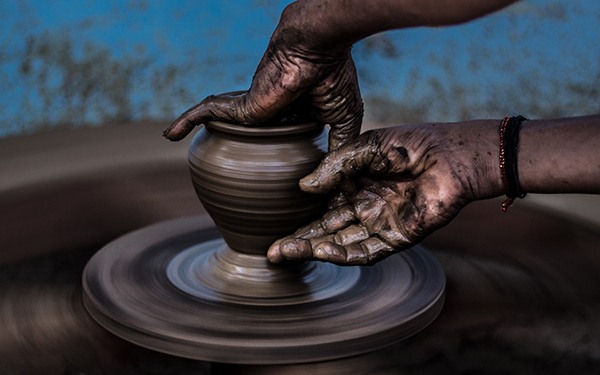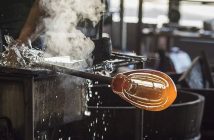Looking for the best pottery wheel? We’ve got you covered.
One of the oldest forms of art in existence, pottery making is good for mind, body and soul.
Not only does pottery making enable us to express our creativity and make useful and beautiful objects, it is also known to be good for the skin, highly therapeutic and can reduce stress levels and increase optimism, plus alleviate anxiety.
Most of all — making pottery is fantastic fun!
Are you thinking about taking up pottery as a hobby?
You’re going to need the right equipment — and that means investing in a quality pottery wheel.
Here’s the lowdown on all you need to know about the best pottery wheels around…
Contents
What is a Pottery Wheel?
Turning a misshapen lump of clay into a stunning object requires a pottery wheel.
Pottery wheels are essentially spinning tables — a little like a record player with a record spinning on it — made from flat, metal, circular surfaces called wheelheads, that allow clay to be shaped into a uniform object using the hands or certain tools.
There is a splash pan that goes around the wheel to catch water and clay as it spins.
Available in a range of different sizes, pottery wheels are either manual or electric. Electric pottery wheels use a motor controlled by a foot pedal to rotate the wheel faster or more slowly depending on the amount of pressure placed on the pedal. Manual pottery wheels work using the same basic principle, but are harder work and require more skill. Instead of a motor turning the wheel, manual wheels — also known as kick wheels — work the same way, except the rotation speed is controlled by the potter himself.
There is a separate wheel at the bottom of the frame that is rotated using the feet, which then in turn rotates the wheelhead at the desired speed.
In this article we’re going to focus on electric pottery wheels, so read on to find out more…
Features of the Best Pottery Wheels
Power
By far the most important factor to consider when purchasing an electric pottery wheel is the motor.
This is what powers the wheel, so it’s essential to have a motor that is powerful enough to easily handle the size and weight of the clay you intend to use for your ceramics projects.
Speed
Different parts of the pottery creation process require the wheelhead to revolve at different speeds, so it’s important to choose a pottery wheel that has a good range of easily variable speeds via the foot pedal.
Left or Right Handed?
Traditionally potter’s wheels rotate in only one direction, which is ideal for right handed folks, but not so easy for those who are left handed.
Left handed individuals should opt for a wheel with a reversible wheelhead motion.
Durability
A pottery wheel is a big investment, so you need to make sure it’s of a decent quality and will serve you for many years to come.
It’s also important to consider how you might develop your pottery techniques in order to choose a pottery wheel that will adapt to you as your skills grow.
Noise
Unlike manual pottery wheels, electric versions do make a certain amount of noise due to the motor. If a chuntering motor is likely to get on your nerves, it’s best to select a pottery wheel with a reduced noise level.
Size
The size of pottery wheel that is best for you is dependent on two factors; the size of your available workspace, and the size of the objects you want to create.
Choose a wheel that fits nicely into your creative space with plenty of room to manoeuvre, and the size of wheelhead (these are available from 8” to 14” in diameter) to best suit your projects.
If you need your pottery wheel to be portable, make sure that it is light and easy enough to move from place to place when you need to.
Tips for Using a Pottery Wheel
- Center your clay. Once you get the hang of centering your clay correctly on the wheel you will be able to create well balanced objects that are easy on the eye. Your wheel should be spinning very fast when you try to center the clay.
- Always keep both your hands and the clay wet.
- Get educated about different mediums. There are numerous different types of clay and not all of them will be well suited to what you want to achieve. Also, clay must be soft and very easy to shape in your hands – if it’s not the right consistency you won’t be able to work with it.
- Correct problems such as the clay going off center or wobbling about as soon as you notice them to prevent them getting worse and ruining your creation.
- Pottery takes time and patience to learn but it should be enjoyable. If you make a mistake – remember that it’s no big deal, just wad your clay right back up and get right back on it.
Here’s a great video full of beginner tips for throwing pots:
Pottery Wheel Cost Guide
How much a pottery wheel costs is dependent on factors such as size, quality, and special features.
Budget pottery wheels can be purchased for as little as $400, but they tend to be smaller and less durable, with slower speeds and lower power.
At the other end of the spectrum, a top end potter’s wheel with all the bells and whistles could set you back somewhere in the region of $2500.
Aiming somewhere in the middle around the $1000 mark should buy you a decent mid range wheel of a good quality, with a powerful motor and a larger wheelhead.
The Best Pottery Wheels
Speedball Portable Artista Table Top Pottery Wheel
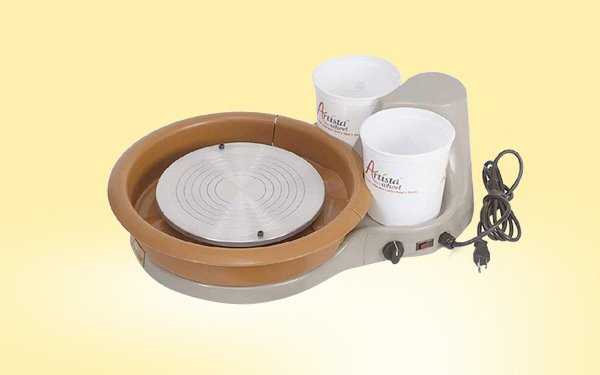
This compact and lightweight pottery wheel is designed to be placed on an existing table or workbench and can be used either when seated or when standing up.
Designed to be sturdy with steel components, this wheel’s 11 inch aluminium wheelhead can hold up to 25 lbs of clay.
It comes with a splash pan to minimize mess and two 2.5 quart buckets for holding water, tools, or additional clay.
The Speedball Portable Artista Table Top Pottery Wheel is operated using a hand control, but can be adapted to be used with a foot pedal if preferred.
It features a quiet, smooth running motor powerful enough to spin the wheelhead at speeds of up to 220 rpm.
Pros
- Ideal for beginners
- Lightweight and portable
- Easy to clean
- Can be used at any height
- Works for all kinds of clay
- Durable
- Small footprint
Cons
- Variable speed hand control can be tricky to get to grips with
- Can sometimes wobble
U.S. Art Supply 3/4-HP Table Top Pottery Wheel
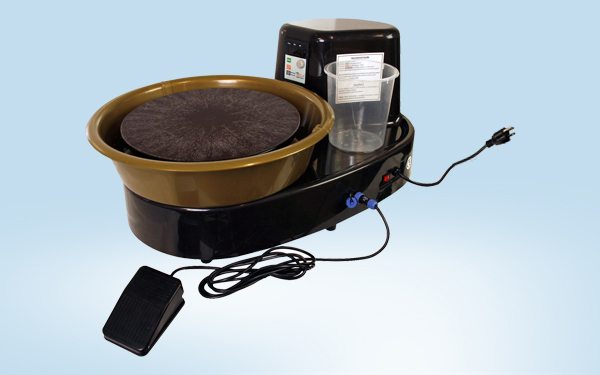
One of the best tabletop pottery wheels on the market, the U.S. Art Supply 3/4-HP Table Top Pottery Wheel features a heavy duty construction with enough weight to prevent it moving around when in use.
Its compact size is convenient, and the 11 inch wheelhead can handle up to 25 lbs of clay and is reversible for left handed potters.
Rotation speed is powered by a 3/4 HP motor, and is variable using either by hand using the control knob, or by attaching the foot pedal provided.
The splash pan is in two parts which makes it easy to remove when it’s clean up time.
Pros
- Built to last
- Suitable for either left or right handed potters
- Easy to clean
- Good variable speed control options
- Powerful motor for the size
- Compact design with small footprint
Cons
- A little heavy to be truly portable
- Splash pan can sometimes leak
Speedball Clay Boss Pottery Wheel
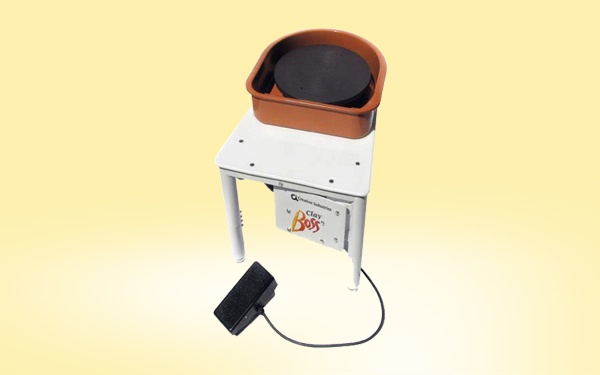
Another fantastic pottery wheel from Speedball, the Clay Boss boasts a 14 inch steel wheelhead for larger projects of up to 100 lbs in weight.
The meaty 1/2 HP motor packs enough punch to drive the wheelhead at speeds of up to 240 RPM, which can be easily controlled using the foot pedal.
This pottery wheel comes ready mounted onto its own steel table with easy clean plastic surface and adjustable legs which allow it to be extended from seated to standing heights to suit your working style.
A clever component of the Clay Boss pottery wheel is the load sensing control which prevents you overloading the machine automatically adapts to maintain the speed of the wheel if you add more clay.
Pros
- Very strong and durable
- Suitable for both beginners and experienced potters
- Reversible wheelhead spin to work left handed
- Easy to use
- Runs smoothly
- 5 year warranty
Cons
- Heavy and not very portable
- Splash pan may be too small for some people
Brent C Wheel

This top of the range electric pottery wheel by Brent C has everything an experienced potter could wish for.
The sturdy welded iron frame and quality industrial components ensure that this pottery wheel is a real workhorse.
The beefy 7 amp 3/4 HP motor can handle clay weights of up to a whopping 225 lbs with ease, and speeds remain consistent and smooth during use; It also runs quietly despite its power thanks to noise filtering technology.
The direction of the 14 inch wheelhead can be easily reversed at the flick of a switch. Speeds can be varied using the aluminium foot pedal, and the roomy splash pan can be removed for easy cleaning.
The wheel is mounted on a sturdy and durable 3 legged work table which can be adjusted in height.
Pros
- Quality product from a reliable brand
- Excellent longevity
- Easy to maintain and replace parts when necessary
- Easy to clean
- Simple to use
- Runs smoothly and quietly
Cons
- Expensive
Speedball Big Boss Pottery Wheel

The third entry from Speedball on our list of the best pottery wheels, the Speedball Big Boss pottery wheel boasts a large 14 inch wheelhead complete with intelligent load sensing control that automatically keeps your wheel revolving smoothly even when adding or removing clay on the go.
The 0.85 HP motor can center clay weights of up to 100 lbs and keep them spinning at speeds of up to 240 RPM, making this a good choice for the adventurous potter looking to work on larger projects.
Wheelhead speed can be easily controlled using the rust resistant aluminium foot pedal, and the direction of motion can be reversed which is practical for left handed people or for intricate detailed work.
The splash pan on this model is roomy, and the whole machine is mounted on a robust steel table for added convenience.
Pros
- Highly durable product
- Excellent splash pan
- Easy reversing control
- 5 year warranty
- Runs quietly
- Smooth, wobble free motion
- Sensitive foot pedal
Cons
- Heavy and not very portable
- Expensive
Which do you think is the best pottery wheel?

